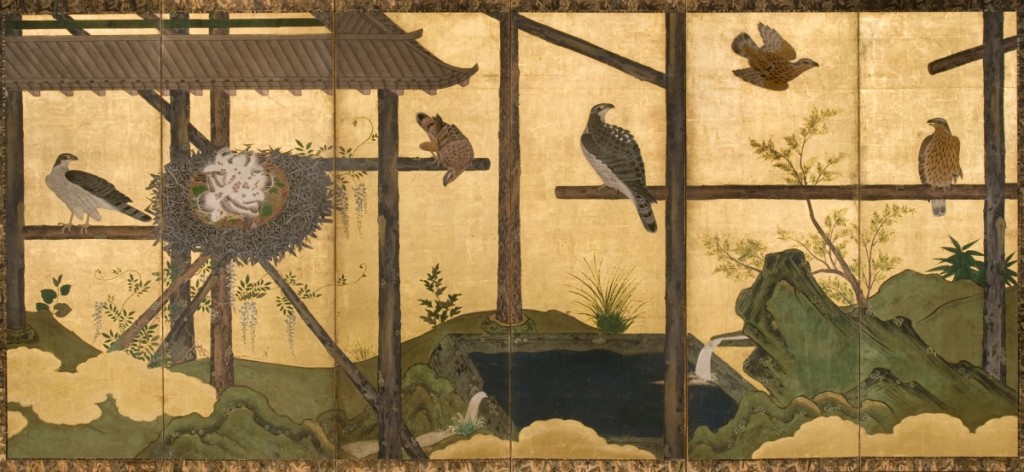
Kan School, “Goshawk Mews,” Edo period, circa 1675, six-panel screen; ink, color and gold leaf on paper, overall: 66-5/8 by 144 inches, Philadelphia Museum of Art: Gift of Mr and Mrs Douglas J. Cooper, 1978.
WASHINGTON, DC – Artworks representing animals – real or imaginary, religious or secular – span the full breadth and splendor of Japanese artistic production. The National Gallery of Art has announced, “The Life of Animals in Japanese Art,” the first exhibition devoted to the subject, covering 16 centuries (from the Sixth Century to the present day) and a wide variety of media – sculpture, painting, lacquerwork, ceramics, metalwork, textile and the woodblock print. On view from June 2 through August 18, the exhibition will feature 315 works, drawn from 66 Japanese and 30 American public and private collections. The artists represented range from Sesson Shukei, Ito Jakuchu, Soga Shohaku, Katsushika Hokusai, Utagawa Kuniyoshi, to Okamoto Taro, Kusama Yayoi, Issey Miyake, Nara Yoshitomo, and Murakami Takashi.
Many of the nearly 180 works traveling from Japan are masterpieces that rarely – if ever – leave the country, including seven designated as an Important Cultural Property by the Japanese government. Three of the registered artworks are from the Tokyo National Museum: two are on loan from the Nara National Museum; and a Fourteenth Century bronze is on loan from the Hosomi Museum, Kyoto.
This historic exhibition is co-organized by the National Gallery of Art, Washington, the Japan Foundation, and the Los Angeles County Museum of Art (LACMA), with special cooperation from the Tokyo National Museum, and curated by Robert T. Singer, curator and department head, Japanese art, LACMA, and Masatomo Kawai, director, Chiba City Museum of Art, in consultation with a team of esteemed historians of Japanese art. The gallery’s presentation of the exhibition, covering 18,000 square feet in the East Building Concourse, is organized into thematic sections that explore the various roles animals have played in the art of Japan. A fully illustrated catalog is being published in association with Princeton University Press.
“The Life of Animals in Japanese Art” takes an expansive look at the representation of animals in a variety of art forms, including painted screens, hanging scrolls, woodblock prints, netsuke, ceramic plates, kimono and samurai helmets. The selection portrays all types of creatures – from foxes and frogs, snakes and sparrows, to mythical animals such as dragons, phoenixes, and kappa river sprites. To explore the many roles animals have played in Japanese culture, objects are divided into eight sections: Ancient Japan; The Japanese Zodiac; Religion: Buddhism, Zen, Shinto; Myth and Folklore; The World of the Samurai; The Study of Nature; The Natural World: Creatures on Land, in the Air, and in Rivers and Seas; and The World of Leisure.
Contemporary artworks spread throughout the exhibition demonstrate the influence of traditional representations of animals on the work of living Japanese artists. The medieval “Deer Bearing Symbols of the Kasuga Deities” is installed alongside Kohei Nawa’s “PixCell-Bambi 14” (2015), while Kusama Yayoi’s polka-dotted three-dimensional dogs are in conversation with haniwa animals, illustrating the similarities in their forms and expressions. Many of the works exhibited employ distinctly contemporary techniques to depict animals. Whimsical creations by designer Issey Miyake transform wearers into a starfish, a monkey or a swallow. In a digital work, “Chrysanthemum Tiger,” 2017, from the Tokyo-based collective teamLab’s Fleeting Flower series, flowers and petals coalesce to form a moving image of a tiger which then dissolves, scatters and takes shape again.
The National Gallery of Art is at Sixth and Constitution Avenues, NW. For information, 202-737-4215 or www.nga.gov.










